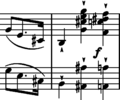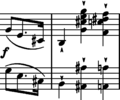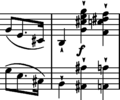



Verbal indications
|
b. 353-354
|
composition: Op. 11, Concerto in E minor, Mvt I
..
The missing dashes marking the range of cresc. are most probably an oversight of the engraver of GE. category imprint: Differences between sources issues: Inaccuracies in GE |
||||||
|
b. 398
|
composition: Op. 11, Concerto in E minor, Mvt I
..
Providing a note that is neither a climax or a turning point or that is not rhythmically emphasised at all (e.g. a strong beat of the bar, syncopation) with a category imprint: Interpretations within context; Editorial revisions issues: Inaccuracies in FE |
||||||
|
b. 466-467
|
composition: Op. 11, Concerto in E minor, Mvt I
..
Omitted dashes determining the range of a given indication (e.g. a dynamic one) are a frequent inaccuracy of the first Chopinesque editions. category imprint: Differences between sources issues: Inaccuracies in GE |
||||||
|
b. 477
|
composition: Op. 11, Concerto in E minor, Mvt I
..
The fact that crescendo is not explicitly led to category imprint: Differences between sources; Editorial revisions issues: EE revisions |
||||||
|
b. 501
|
composition: Op. 11, Concerto in E minor, Mvt I
..
The fact of assigning category imprint: Interpretations within context; Differences between sources issues: GE revisions , Centrally placed marks |




 under e2 in sources
under e2 in sources 
 2, our alternative suggestion
2, our alternative suggestion




 may be explained by an oversight of the engraver or an inaccurate reproduction of [A] – handwritten indications are often much more expanded than the printed version, since it is impossible to reproduce them in such way (cf. e.g. the Mazurka in A
may be explained by an oversight of the engraver or an inaccurate reproduction of [A] – handwritten indications are often much more expanded than the printed version, since it is impossible to reproduce them in such way (cf. e.g. the Mazurka in A major, op. 24 no. 3, bars
major, op. 24 no. 3, bars 

 in
in 